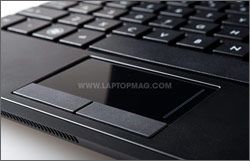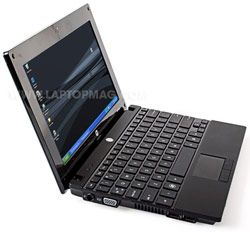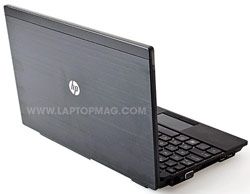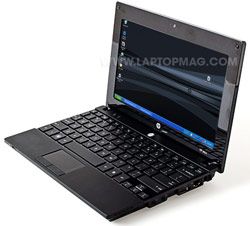Laptop Mag Verdict
This business-friendly netbook offers excellent performance in a durable and attractive design.
Pros
- +
Stylish, durable design
- +
Comfortable keyboard
- +
Excellent performance
- +
Good audio
Cons
- -
Touchpad has too much friction
Why you can trust Laptop Mag
HP introduced the concept of the durable business-class netbook, and the Mini 5101 raises the bar with a more compact design and even longer battery life. This $425 machine is slightly more expensive than other netbooks, and the touchpad is a little finicky, but the Mini 5101 will no doubt appeal to business travelers who need their netbooks to handle some abuse while on the road.
Design
The HP Mini 5101 should look familiar to anyone who has seen HP's ProBook line. Unlike its previous business-oriented netbooks--which had a silver, brushed aluminum chassis--the 5101 is all black. While the lid is a brushed aluminum, the deck and underside (which is made of a durable magnesium alloy) are coated in soft rubber paint (called SoftTouch) that was very comfortable.
Measuring 10.3 x 7.1 x 0.9 inches, the Mini 5101 isn't the sveltest of netbooks, but it's still easy to carry. While it does have an extended battery, it doesn't protrude from the back of the system, as with theToshiba mini NB205; rather, it bulges slightly from the bottom. At 2.8 pounds, the 5101 is about average when it comes to netbook weight.
Keyboard and Touchpad
Also in a departure from theMini 2140, the keyboard (which is 95 percent of full size) has an island layout. While there's more space now between each key, it was still easy to reach all of them, and the right Shift key is in the correct place. The keys have a rough, textured feel that's comfortable to type on for extended periods. Like HP's previous business netbooks, the keys are coated with a finish that HP claims makes them 50 times more resistant to visible wear. Additionally, the keyboard can withstand minor spills.

Click to enlargeThe touchpad on the Mini5101 is a bit small at 2.5 x 1.4 inches (compared to 3.1 x 1.6 inches for the Toshiba mini NB205). Moreover, the glossy black surface on HP's touchpad had too much friction, making it somewhat difficult to move the cursor. Still, the mouse buttons, also covered in a soft rubber, responded crisply. We were more than pleased to see that the buttons were below--as opposed to astride--the touchpad, as they were with previous incarnations of HP netbooks.
Display and Audio
The matte, 10.1-inch display on the 5101 had good viewing angles both vertically and horizontally; its resolution of 1024 x 600--typical for a netbook--was crisp enough for us to enjoy watching movies streamed from Hulu, as well as downloaded high-def content. A 720p video clip ("Super Speedway," from the Windows HD Content Showcase) played back smoothly, without any pauses or interruptions, and we could clearly make out the detail in the race cars.
The forward-facing stereo speakers, located under the front lip of the system, provided loud and balanced sound for a netbook. While watching a movie or listening to music from Pandora, we were able to easily make out lyrics from across a room, and the bass provided enough oomph to let us know it was there.
Ports and Webcam
The 5101 has the typical netbook array of ports: two USB and a VGA port are on the left side, and the right houses one more USB port, Ethernet, headphone and mic jacks, and an SD Card reader.
The 2-megapixel webcam offered excellent images when chatting with a friend over Skype; she could clearly make out the colored pinstripes of our shirt, and reported little in the way of motion blur when we waved our hand in front of the camera.
Performance

Click to enlarge
Powered by a 1.66-GHz Intel Atom N280 processor and 1GB of RAM, the Mini 5101 acquitted itself very well on our benchmarks, outperforming other netbooks with the same specs. On PCMark05, the 5101 scored 1,626, blowing by the average of 1,383, and coming in second overall to theDell Latitude 2100, which scored 1,697. Needless to say, it was more than capable of allowing us to write this review, browse the Web, chat in Skype, and watch a movie in Hulu.
While the hard drive on the Mini 5101 has a netbook-typical capacity of 160GB, it spins at a faster 7,200 rpm. On the LAPTOP Transfer Test, it was able to duplicate a 4.97GB folder of multimedia at a rate of 23.1 MBps--equal to that of theASUS Eee PC 1008HA, and well above the category average of 15.0 MBps.
The 5101's graphics performance, too, was above par, notching 782 in 3DMark03, and 127 in 3DMark06; those scores bested the category averages of 642 and 97, respectively.
The 5101 also did fairly well when transcoding a 114MB MPEG-4 file to AVI using Handbrake; the system took 27 minutes and 58 seconds, which is a little more than a minute better than the netbook average.
Heat
While the deck of the Mini 5101 remained a relatively cool 88 degrees Fahrenheit during our battery test, the middle of the underside became an unpleasantly warm 95 degrees.
Wi-Fi and Battery Life
The 802.11a/b/g/draft-n radio delivered extraordinary throughput of 37.7 Mbps at 15 feet, and 21.4 Mbps at 50 feet from our access point. This far outpaces the netbook averages of 19.0 and 15.8 Mbps from those respective distances. The Mini 5101 also comes with Bluetooth 2.0, and can be installed with Gobi wireless broadband; users can insert a SIM card by removing the battery.
The Mini 5101's six-cell battery lasted a very good 7 hours and 52 minutes. While that's far short of the 9:41 offered by theToshiba mini NB205-N210, it exceeds the netbook average for six-cell batteries by nearly two hours, and should provide more than enough juice for a cross country flight.
Configurations

Click to enlarge
HP will offer four preconfigured models of the Mini 5101. In addition to the one we reviewed, a less expensive $399 version will be offered; it's otherwise identical to our review unit, but comes with a smaller four-cell battery. A $525 model (FM956UT) will be outfitted with Windows Vista, 2GB of RAM and the four-cell battery, and the top-of-the-line $599 version (FM976UT) will have Windows Vista, 2GB of RAM, a 320GB, 7,200-rpm hard drive, and a six-cell battery. Both Vista models will also come with an XP downgrade option.
Unlike many netbooks, users will be able to configure the 5101 in a variety of ways. Apart from the 160GB hard drive, HP will offer a 250GB ($45) and 320GB drive ($100), both of which spin at 7,200 rpm. The company will also offer a 128GB solid state drive--though at $450, it will cost more than the netbook itself. The Mini 5101 will also be offered with Windows Vista Home Basic; customers who select this option will also be eligible for the Windows 7 upgrade.
Like the Mini 2140, customers will also be able to opt for a higher resolution 1366 x 768 display (a $25 option); while this would seem an improvement, in our previous tests we've found that the extra resolution goes to waste on a screen this small.
Software and Warranty
The 5101 is refreshingly free of trialware, and, as a first, includes Corel Home Office, a Microsoft Office-style program that was designed specifically for netbooks. However, McAfee Total Protection was extremely intrusive; its default firewall settings attempted to block just about every application seeking Internet access; it became very frustrating having to allow access for such benign programs as Skype.
The 5101 comes with a one-year limited warranty. Click here to see how HP fared in our Tech Support Showdown.
Green Testing

Click to enlarge
The HP Mini 5101 is pretty green when it comes to netbooks. It received an EPEAT rating of 21 out of 28; that's not bad considering no notebook has yet to make it past 22.
HP claims that its Fast Charge technology enables the battery to recharge to 90 percent in 90 minutes; we found it actually took 79 minutes using the LAPTOP Battery Charge Test--but 2:07 to fully recharge. During that time, the 5101 drew an average of 45.9 watts, which seems high in comparison to other notebooks (theSony VAIO SRdrew an average of only 32.2 watts while recharging); however, when divided by the battery life, the 5101 used only 11.8 watts per minute of battery life. That's lower than the Mini 2140 (13.6 watts), and just short of theEee PC 1008HA, which only used 11.1 watts per minute.
Verdict
In the price-competitive world of netbooks, $425 is a lot to pay for a system whose battery life falls an hour and a half short of those that cost $75 less. However, in the Mini 5101, HP gets a lot of things right: its business-rugged design makes this netbook more durable than consumer-focused systems, and its performance is better than the majority of the netbooks on the market. It also has convenient security tools. Road warriors looking for a netbook that can withstand being jostled around would do well to consider the HP Mini 5101.
[flq:163035ceb59a421495204b129fc8bf38]
HP Mini 5101 Specs
| Bluetooth | Bluetooth 2.0 |
| Brand | HP |
| CPU | 1.66-Ghz Intel N280 |
| Card Slots | 2-1 card reader |
| Company Website | http://www.hp.com |
| Display Size | 10.1 |
| Graphics Card | Intel GMA 950 |
| Hard Drive Size | 160GB |
| Hard Drive Speed | 7,200rpm |
| Hard Drive Type | SATA Hard Drive |
| Native Resolution | 1024x600 |
| Operating System | MS Windows XP Home |
| Ports (excluding USB) | Microphone, Kensington Lock, Headphone, Ethernet, VGA |
| RAM | 1GB |
| RAM Upgradable to | 2GB |
| Size | 10.3 x 7.1 x 0.9 inches |
| USB Ports | 3 |
| Warranty/Support | one-year limited warranty |
| Weight | 2.8 pounds |
| Wi-Fi | 802.11a/b/g/draft-n |
